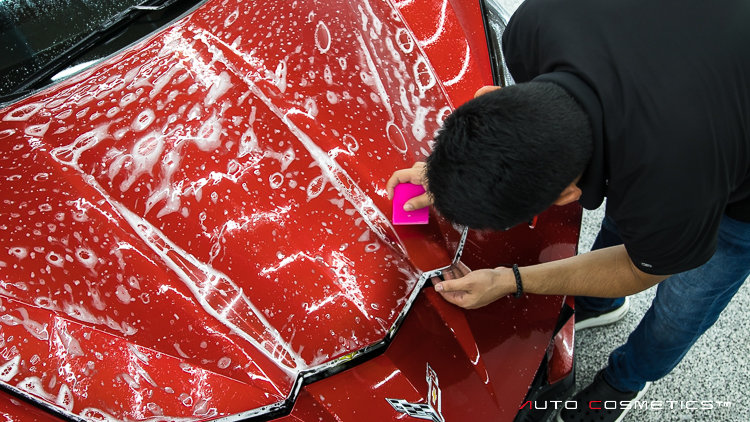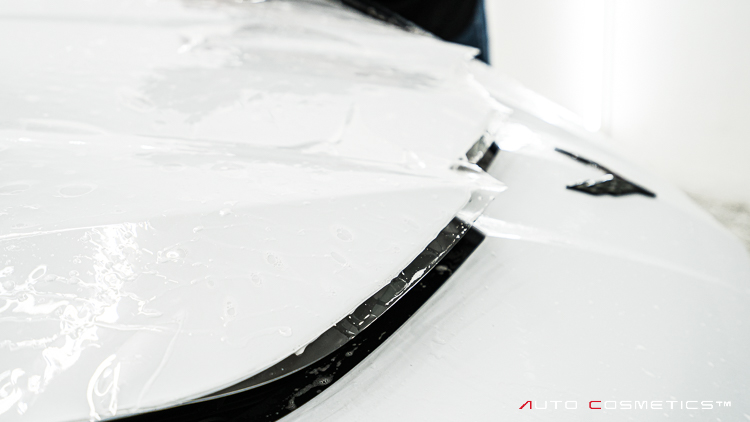What is the Best Paint Protection Film?

ON THIS PAGE:
Overview
Don’t you wish there was a way to keep your car’s paint looking as crisp, shiny, and blemish-free as it was the day it rolled off the lot? It turns out there is. Paint protection film, also known as a clear bra or PPF, covers high-impact areas of your car with a transparent barrier to keep the paint safe from all kinds of threats.
The best part is that the top-rated films even heal themselves when they’re scratched or scuffed. Sounds too good to be true, right? It’s all true.
If you’re interested in having paint protection film installed on your car, there’s a lot to learn and consider before making the best decisions for your situation.
Since the most pressing issue is finding out which PPF is best, this article will look at clear bras’ different types and qualities, how this film protects a car, and the best time to get one installed.
Professional Clear Bra Installations
LEARN MOREPaint Protection Film Explained
Clear bras are constructed of elastomeric polymer urethane (polyurethane). Polyurethane is a tough, clear, and self-healing material. Think of it as a second skin or an invisible shield for your car. This film can heal itself by rearranging its molecules to their original “positions” with a little bit of heat; heat from the sun will do the trick.
Not all PPF is created equal. There are low-quality products out there and exceptional products that you have to see to believe. In addition, all installations aren’t the same; to get the most protection and the longest life from your paint protection film, you’ll need to have it professionally installed.
When properly installed, PPF can last for years; a 10-year warranty backs the best films in the industry. Proper installation is crucial for the level of protection your car deserves.
The best films will effectively:
Protect paint against acid rain
Retain your car’s resale value
Self-heal from small scratches and scuffs
Stop chips from rocks
Block UV rays to prevent paint discoloration
Shield your vehicle against bugs and bird droppings
Block against damage from mineral deposits
Prevent etching and stains
The film is applied using a strong, clear adhesive. When it’s time to uninstall the clear bra, removal doesn’t damage the paint if done carefully and properly.
Understanding PPF: Good vs. Bad Quality
There are several types and brands of paint protection film on the market (XPEL, SunTek, STEK, Clear Guard Nano, Bekaert, Avery, Venture, Llumar, 3M, and Madico), so knowing the difference between the top and the bottom of the quality scale is important. What began as a protective film for the military has now been enhanced for consumer applications and comes in many different styles.
The various brands and types of clear bras have different thicknesses, varying warranties, and disparate self-healing capabilities. The best films have a thickness of at least six mils (one mil is 1⁄1000 of an inch), and they’ll also come with a strong warranty; 10 years is currently one of the best on the market and is available for XPEL paint protection film.
Low-quality protective films come with warranties of just five years or less, and they are quite a bit thinner than the high-quality films, measuring five mils in thickness or less. In addition, you’re going to want that self-healing capability. Lower-quality films don’t have that ability.
How Does PPF Protect Paint Against the Elements?
Any car’s paint takes quite a beating from rocks, birds, debris, sand, other people, and even rain. This damage is especially frequent for the vehicle’s front end, so some PPF treatments will be applied only to the car’s nose.
One of the top paint protection films, XPEL Ultimate Plus, offers four protective layers when it’s installed on a vehicle:
The clear coat (0.5 mils thick)
Polyurethane (6.0 mils thick)
The acrylic adhesive (1.1 mils thick)
The polyester release liner (3 mils thick)

Each layer is an important part of the protection provided to your car. The polyurethane layer, which is 6.0 mils thick, is the layer that provides self-healing protection.
Paint Protection Film: Things to Consider
The installation of your film is as important a consideration as which film you choose to use. Never settle for anything less than a shop with certified, experienced installers and a stellar reputation. If possible, check out previous jobs they’ve done installing clear bras.
Ensure the shop advises you of all of the available packages, and they should answer your questions clearly and directly until you are satisfied. Two other things to consider are wrapping your edges and getting a ceramic coating to work with your PPF.
Wrapping Edges vs. Leaving a Quarter Inch from the Edges

As you can imagine, having the edges wrapped will not only protect your car better (there’s paint at the edges, too), but it will also look better. Over time, dirt can collect next to a film stopped a quarter inch from the edges. This build-up is especially noticeable on light-colored vehicles.
Most shops will generally charge more to wrap the edges, but it’s well worth the additional expense.
Ceramic Coating and PPF
Adding a ceramic coating over paint protection film gives top-tier protection that looks amazing. It’s beneficial to have it installed over a clear bra because the ceramic coating is hydrophobic; water falls right off. Ceramic coatings stay clean longer because they’re slick. Other liquids, like bug spatter and bird droppings, wash off very easily.
Reasons for Removing a Clear Bra
Most people don’t ever really want to remove paint protection film unless one of three things happen: They rented the vehicle, and it’s time to give it back, they have gotten into an accident, and it needs to be removed for car repairs, or the clear bra starts to show signs of wear.
In all these instances, you should trust an experienced professional to perform the removal. Insurance companies will likely pay to replace your film, especially if you informed them when you installed it.
When is the Best Time to Install PPF?
As soon as you take possession of your car, it would be best if you took it in to have paint protection film installed. It’s best to do this right away before unnecessary exposure to debris, dirt, and other hazards.
If you have an older vehicle, you might need a paint touch-up before installing a clear bra. Likewise, your car might require paint correction before PPF installation if it has deeper scratches or swirl marks.
How Much Film Should I Put on My Car? What Should I Protect?
This answer depends on the type of driving you do and your budget. A lot of highway driving would suggest that at least a full front application be installed. This PPF would cover the front bumper, the hood, the fenders, and the side mirrors.
If your budget is tight, you can opt for a partial front application. Alternatively, you could apply the film only to certain parts of the car, like rocker panels, rear-wheel impacts, or door cups.
The Best Paint Protection Film
Auto Cosmetics professionally installs XPEL ULTIMATE PLUS paint protection film. It’s backed by a 10-year warranty and is the premier film on the market. The choice is clear with features like superior damage protection, self-healing capability, resistance to stains and discoloration, and Edge Seal Technology.
Set up an appointment with us for your PPF installation today.
